

Efforts to inculcate positive qualities in children at school is a noble goal, which none will criticise. However, teaching moral values and ethical behaviour without being dogmatic or sectarian is very difficult, unless an effective, non-sectarian technique is available to teach mastery over the mind. This is because without some mastery over their wild “monkey mind”, people (and not just children!) find it very difficult to adhere to moral values in practice. Everyone will agree that it is important for children to learn basic moral values and that living an ethical life improves one's own happiness and contributes to the happiness of others. Everyone will also agree that achieving some mastery over the mind through improved awareness and concentration is essential in all human activity; but mere preaching is of little use.
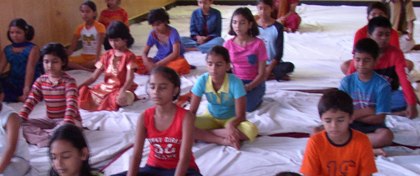
Anapana meditation to improve awareness and concentration
(Mumbai, India)
Introducing such training in moral values, awareness and concentration so that it becomes an integral part of school education would greatly improve the behaviour and relationships of children and help them to maximise their educational opportunities. Since children belonging to different religious and ethnic groups study together in schools, it is important that this training be non-sectarian. No one should find it objectionable - it needs to be acceptable to all, regardless of their background. It should also be simple and easy to understand and practice. Most important, it should be effective; that is, the training should actually have concrete results that actually improve personal well-being and lead to harmonious social interactions.
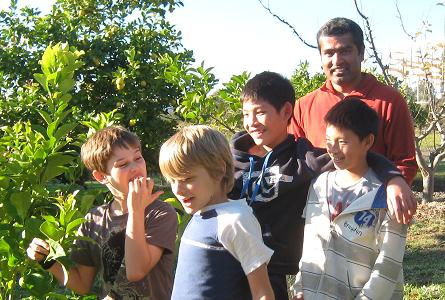 Children's course at Vipassana centre in Melbourne, Australia
Children's course at Vipassana centre in Melbourne, Australia
We have such an effective non-sectarian technique in Anapana meditation. Anapana is the first step in learning the technique of Vipassana. While serious courses in Vipassana are for adults, Anapana can be easily learnt by children from an early age. In Anapana they find a technique that is simple, focused on natural respiration and thus devoid of sectarian associations. Children are by nature active and enthusiastic with an eagerness to learn, to explore. At this age it is so appropriate to offer them an opportunity to explore themselves and their minds with all their hidden faculties, latent abilities and subtle complexities. At the same time that they learn to observe their active minds, they come to understand how to develop a more focused attention on the present moment.
When so much that society offers to children is based on materialism and the quest for instant gratification, Anapana provides a much needed method of getting in touch with their inner selves and a way to deal with the very fears and anxieties of childhood and adolescence. The children rise to this challenge very naturally.
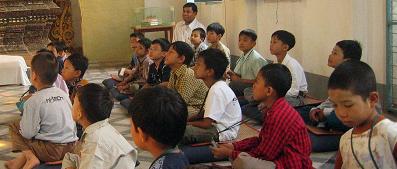
Boys in Myanmar
Anapana Meditation Courses
Anapana meditation involves the objective observation of one's own respiration. Natural respiration as an object of meditation is acceptable to all, irrespective of caste and creed. It is the only bodily function that is conscious as well as unconscious; that can be intentional as well as unintentional; that is voluntary as well as involuntary; that is constant; and that is so closely linked with our mind, our mental state. This was why the Buddha used observation of the natural respiration as a key meditation technique.
Courses conducted exclusively for children are a wonderful opportunity to make available the manifold benefits of the Anapana technique. These courses are held at educational institutions as well as at Vipassana centres. The Anapana courses last from one to three days. The daily timetable has been developed after considerable experimentation. The courses are specifically designed to meet children's interests and capabilities and are conducted by children's course teachers and assistant teachers of Vipassana who have been specially trained to lead them.
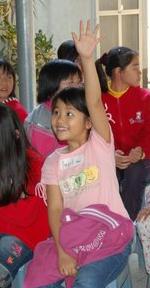 |
The courses impart essentially a mental practice, but care is taken not to let meditation be a burden for the child. The focus is the practice of Anapana meditation, the observation of natural respiration -mere objective observation - to develop awareness, concentration and tranquility. The courses include activities suitable for children, such as stories, games, creative activities, and keeping a diary. The children, who range in age from eight to sixteen years, are taught using audio and video recordings. The teachers monitor the program, help the children to better understand the teachings and practice, and help them integrate the experience into their daily lives. In these groups the children learn interactively. |
| Question time in Hong Kong |
The message is simple, straightforward and logical: A good person is one who does not harm others by mental, vocal or bodily actions; who helps others; who has mastery over his or her mind and who purifies the mind. If a Hindu has these qualities, he or she is a good person. A Muslim who has these qualities is a good person. A Christian, a Buddhist, a Jew, an Indian, an American, or a Japanese person, of this or that ethnic group - whoever has these qualities is a good person. Children really like this universal definition of goodness.
Anger, hatred, jealousy, fear, passion, craving, etc. are the defilements that make our minds impure, making us miserable. The course starts with taking five moral precepts. The five basic precepts of the Buddha's teachings are explained to the children from the perspective of their own benefit and well-being, as well as the benefit and well-being of others. These precepts are: not to kill, not to steal, not to lie, not to use intoxicants, and to abstain from sexual misconduct. The teachers explain that merely knowing or memorizing these will not help--they must be applied if they are to be beneficial.
Through stories and examples, the children hear about how practising the technique of Anapana helps to strengthen the mind with concentration and awareness, supporting their resolve to follow the precepts. The values of respect and gratitude towards parents, teachers and elders, and the value of keeping company with wholesome people are highlighted. Children are receptive to this because they are meditating at the same time, learning through their own experience the affect of wholesome and unwholesome actions on their breath, and ultimately on their mind.
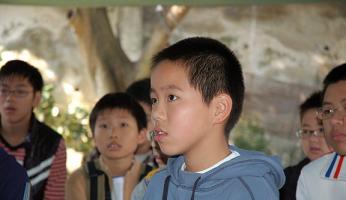
Children at Hong Kong Vipassana Centre
The Benefits of Anapana
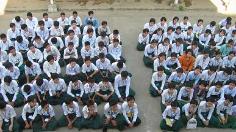 The number of courses being held in India and elsewhere in the world is increasing rapidly. Each year, tens of thousands of children participate in children's courses in India and many courses are also held in western countries. The response to these courses has been positive. The immediate and long-term benefits are clearly significant in helping children to become established in lives of positive action with a strong moral foundation at an early age. The academic performance of those children who continue to meditate at home or at school improves because the meditation helps to improve their concentration, memory and self-control.
The number of courses being held in India and elsewhere in the world is increasing rapidly. Each year, tens of thousands of children participate in children's courses in India and many courses are also held in western countries. The response to these courses has been positive. The immediate and long-term benefits are clearly significant in helping children to become established in lives of positive action with a strong moral foundation at an early age. The academic performance of those children who continue to meditate at home or at school improves because the meditation helps to improve their concentration, memory and self-control.
Studies assessing the courses show an increase in qualities like discipline, honesty, co-operation, attentiveness, cleanliness and concentration; and a decrease in irritability, quarrelling, use of abusive language and feelings of inferiority. The studies were carried out by administering questionnaires to parents and teachers. It is evident that the courses have a positive impact on children, thereby facilitating reform at the basic social and cultural level.
The school teachers are asked to participate in the course along with the students. This not only helps the teachers to lead by example, but it also motivates them to become partners and co-workers in this constructive activity. Positive results occur most readily when the children are given an opportunity to continue the meditation regularly at home or at school.
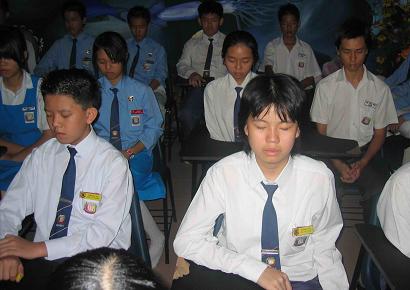
School students meditate before class in Johor, Malaysia
It is very useful when parents or teachers meditate with the children. This is a crucial aspect. Children are wary of preaching; they don't like sermons, but when they see their teacher engaged in the same work he or she is asking them to do, they respond easily and eagerly. This non-dogmatic, non-pedantic nature of Anapana courses is especially appealing. Hence more efforts are now being made to organize courses in schools where there will be an opportunity for the children to continue their practice of meditation. In most institutions, this is done by providing a slot of about 10 to 15 minutes for meditation in the timetable.
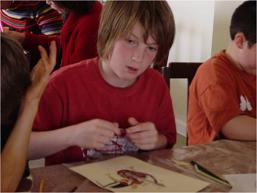 |
| Boys in UK |
The following are some representative comments from children who took an Anapana course:
"After taking this course I feel that everyone should take this course."
"It's challenging and tough at first but enjoyable later on. It is good to look at oneself."
"I have gained a lot, got lots of calmness out of this course."
"It is difficult but essential; will sure help me in my studies."
"I just can't say how wonderful it is here. I wish my elder sister could have come."
"I learnt that my mind is like a monkey, always wandering. And I have learnt how to control it."
"I did this course last year and it helped me a lot in my studies. Now I have come again."
"I liked the serene, peaceful atmosphere here and though meditation is difficult at times, it is very beneficial."
"I hope by doing Anapana I will become a better person."
"I get angry very easily, but with Anapana I can control my anger."
The reactions of parents and teachers are also encouraging. A school teacher who used to meditate with students before beginning the lessons was asked by fellow teachers the secret behind the exceptional peacefulness in her classroom. Another teacher found that her interaction with the students had become more harmonious. A mother reported that before the course there was tension between her son and herself; that after Anapana there was better understanding between them; that they were now closer than ever before.
There is a common misperception that meditation is something mystical and sectarian and not relevant to everyday life. This myth is shattered when one sees the peace and harmony of children from diverse backgrounds who practise Anapana together.
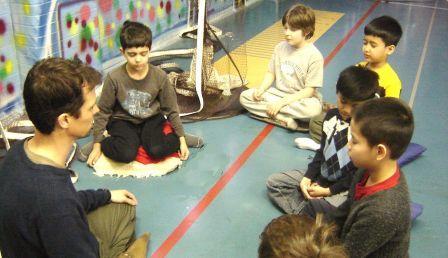 Boys at a school in Philadelphia, USA
Boys at a school in Philadelphia, USA
May children everywhere learn this wonderful technique - for their own benefit, for the benefit of their school and for the benefit of their families and community.